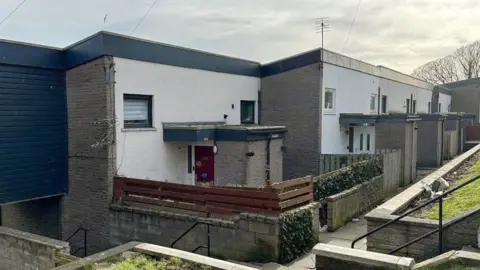Raac residents offered alternatives to demolition
 BBC
BBCAberdeen residents living in homes blighted by potentially dangerous concrete are to be given the opportunity to explore alternative options to demolition.
More than 500 properties - most of them council-owned - were found to contain reinforced autoclaved aerated concrete (Raac) in 2023.
Aberdeen City Council previously agreed to demolish the homes.
However residents will now be able explore alternative options for the future of their properties.
A council meeting heard these included securing the agreement of all households in a given block to share the cost of a new roof instead of having to move out.
The local authority wants to buy and demolish homes through voluntary acquisition, but there have been disputes about the valuations.
After a meeting on Tuesday, home owner Lynn Winstanley said she was "very, very disappointed".
She added: "They want us to pay for the roofs. People are still going to be out of pocket.
"People don't have money to go and pay £40,000 or £50,000 for a roof.
"If they did they would have done it already."
Ms Winstanley, who runs an online support group for fellow Raac residents, lives in a block of four and said the situation was very stressful.
And she added her and her neighbours were "adamant" they were not going back to renting.

Councillor Miranda Radley, convenor of the communities, housing and public protection committee, said homeowners would now be consulted on what they wanted to do.
"I understand the impact that this is having on all homeowners," she said.
"We are trying to work with them and trying to find creative solutions to solve their problems.
"We're working within the legal frameworks that we have available to us to offer as much as we can at this point."
A total of 138 private properties and 366 council homes the Balnagask area were found to have Raac in their roof panels.
In March, plans for the phased demolition of homes moved forward.
The plans to demolish and rebuild the properties are expected to cost more than £150m.
What is Raac?
Raac stands for reinforced autoclaved aerated concrete.
It is a lightweight material that was used mostly in flat roofing, but also in floors and walls, between the 1950s and 1990s.
Raac is a cheaper alternative to standard concrete, is quicker to produce and easier to install.
But it is less durable and has a lifespan of about 30 years.
Its structural behaviour differs significantly from traditional reinforced concrete.
It is also susceptible to structural failure when exposed to moisture. The bubbles can allow water to enter the material.
Raac is often coated with another material, such as bitumen, on roofing panels. But this material can also degrade.
The Health and Safety Executive (HSE) said Raac is now beyond its lifespan and may "collapse with little or no notice".
